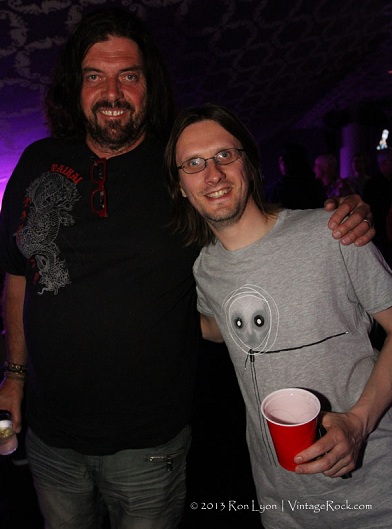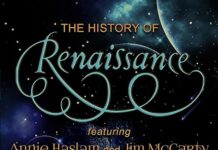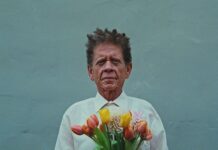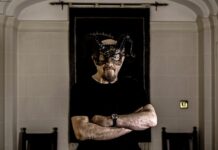Alan Parsons landed a job at the famous Abbey Road Studios at the age of 19, and it became clear that the world of sound recording was to dominate his career. He was fortunate enough to work as assistant engineer on the last two albums by the Beatles and after he qualified as a fully-fledged recording engineer, he went on to work with Paul McCartney and the Hollies, among many others.
But it was his contribution as engineer on Pink Floyd’s classic The Dark Side Of The Moon that really got him world attention. That soon led to striking successes as a producer — notably with Pilot’s “Magic,” John Miles’ “Highfly” and “Music,” and Steve Harley’s “Make Me Smile (Come Up and See Me).” He also produced the hugely successful Year Of The Cat album with Al Stewart and two albums with American progressive rock band Ambrosia.
In 1975, he met Eric Woolfson, who not only became his manager, but joined forces with Parsons as a songwriting and performing partner for what became known as the Alan Parsons Project. Today, he continues to produce and tour the world. This year, he returned to his roots when he engineered the third solo album from Porcupine Tree’s Steven Wilson, The Raven That Refused To Sing (And Other Stories). I had the privilege recently of speaking with Parson about producing, about his own band, and also about Austin Powers.
~
Alan, in your view, how do you think the role of producer changed over the years?
The original concept of what a producer was, was a guy who sat at a desk with a big fat cigar saying. ‘Hey guys, I’m gonna make you into stars’ (laughs). He would choose the material and deal with the artist on a musical level. All the technical stuff would be handled by the engineer. That doesn’t really happen anymore — the roles have melded into one. I was perhaps one of the first people to produce and engineer at the same time. Countless people do it now and virtually every musician on earth has become a producer and recording engineer in their own right because they’ve got Garage Band on their Mac laptop.
How did you make the transition that you did?
It sort of happened by accident. I started producing by default because sometimes the bands I was working with didn’t have a clue what they were doing. I was sort of a loudmouthed engineer, I suppose, that’s how it all started for me. I’d say something if a guitar was out of tune — and that was not an engineer’s place. You just dealt with the balance, mics, tape distortion — those sorts of things.
Were you aware early on that some of the sessions you were engineering would live as long as they did?
I was in seventh heaven being in the same room with the Beatles and I think it was already a foregone conclusion that their music was already timeless. With Pink Floyd, however, we knew that we were making something very special at that time, but I don’t think any of us thought we’d still be talking about it 40 years later.
Was it tough, even as an assistant engineer, to manage through the relationships with the Beatles in the studio?
I had a job to do and I tried to do it o the best of my ability but you could not help noticing that there were a number of personal conflicts between them, especially on Abbey Road, the last album. By the time that came along, they were literally avoiding each other, coming in one at a time to work on their own songs. It was not so much a band record, but the efforts of individual Beatles.
Still you must have learned a lot in those sessions.
I was new to the game back with the Beatles so every day I was on a constant learning curve. I’d learn more about recording by talking to engineers rather to people like the Beatles. It wasn’t really an assistant engineer’s place to talk to the artists. I spoke when spoken to as far as the band was concerned (laughs). With Glyn Johns on Let It Be, I fired questions at him all the time. And I learned early how to listen. That’s the key: LISTEN.
Talk about how you then became a star yourself with the Alan Parsons Project.
IIt was kind of an accident. Singer Eric Woolfson came to me with the idea of making an album based on Edgar Allen Poe stories. We’ll make it heavily orchestrated he said, we’ll get lots of different singers, involve bands I’ve already worked with and I really thought Edgar Allen Poe was going to be the star — not Allen Parsons. So it was kind of strange when the label, which was referring to the album internally as The Alan Parsons Project — you know, “How’s Alan Parsons’ project coming along?” — said, let’s just call it The Alan Parsons Project. They liked that. And it stuck! Then suddenly, I’m thrust into the limelight, I’m starting to do interviews, appear at events — and so it was sort of a major change overnight.
Did the instant success surprise you?
We were fortunate that radio formats in the 70s were much more forgiving, playing lengthy tracks and literally the whole album in some cases. So were blessed by having an ideal vehicle to promote it — the radio — it’s almost impossible to break an album on the radio today. And of course we didn’t have a live act, which also made us different! We promised ourselves it would be just a studio outfit. I am a musician of sorts, a reasonable guitar player, but not really a performing artist. I’ve gotten more into it since then but back then, no.
You also produced Al Stewart’s Year Of The Cat around then.
I’m very proud of that record. I also liked the previous album, Modern Times, but Year Of The Cat of course had the hit so likely that’s the catalyst to being my favorite from that period in terms of productions.
And then you also reached a certain pop culture status being included in the second Austin Powers movie.
The only frustration with the Austin Powers thing was that they didn’t get in touch with me and I could have contributed something more — some music or appeared in the movie! It was a complete surprise — a friend said, “You have to go see this movie — you’re going to die” (laughs).




















